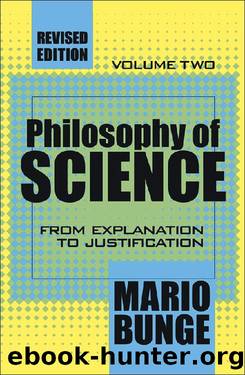Philosophy of Science Volume 2 by Mario Bunge

Author:Mario Bunge [Bunge, Mario]
Language: eng
Format: epub
Publisher: Taylor and Francis
Published: 2017-09-04T00:00:00+00:00
Problems
12.5.1. The astrophysicist A. Eddington claimed—in the tradition of Kant—to possess a priori knowledge of the physical world, a knowledge derived purely from epistemological principles. Examine this claim and the accompanying programme: see Eddington’s The Philosophy of Physical Science (Cambridge: University Press, 1939). Next, see the criticisms of L. S. Stebbing, Philosophy and the Physicists (London: Methuen, 1937), and M. Bom, Experiment and Theory in Physics (London: Cambridge University Press, 1944). Finally, discuss whether such a priori attempts as Eddington’s could possibly succeed.
12.5.2. Flowers had been observed by man during one million years before it was suspected (1694) that they are the sexual organs of plants; moreover, artificial pollination was extensively practiced by the Sumerians five millenia ago. Why did observation and action fail to generate botany?
12.5.3. Discoveries have often been made by chance. For an enthralling narration see R. Taton, Reason and Chance in Scientific Discovery (New York: Philosophical Library, 1957). Now, L. Pasteur said that chance can teach something only to prepared minds. Prepared by what?
12.5.4. Do atomic physicists and psychologists take cognizance of their objects through the senses? Make sure to distinguish the referents of their ideas from the evidence relevant to those ideas. Alternate Problem: Descriptive anatomy is a set of accurate observation reports. Is it an independent science?
12.5.5. Drawing room physics became fashionable towards the middle of the 18th century and remained so until late 19th century. Favorite exhibitions were those of electric and magnetic phenomena, which were shown for entertainment rather than for understanding: no science of electricity and magnetism was evolved by that means. Similarly, countless observations were made on drawing room hypnotic phenomena, which added nothing to an understanding of hypnosis. Why this sterility of accurate observation? Alternate Problem: In 1776 M. van Marum observed that electric discharges magnetized iron pieces, but failed to “interpret” this as an interaction between electricity and magnetism, and his observation remained buried. In 1887 H. Hertz observed what we now call the photoelectric effect but failed to “interpret” it as the extraction of electrons by light, whence he is not usually credited with the discovery. Draw some moral.
12.5.6. Evaluate (i) the knowledge concerning isolated facts and (ii) the knowledge of isolated generalizations. Regarding the former see H. Helmholtz, Popular Scientific Lectures (London: Longmans, Green, and Co., 1873), p. 369. Concerning the latter, see E. Schrodinger, Science: Theory and Man (New York: Dover, 1957), p. 93. Alternate Problem: By building more and more powerful particle accelerators, the number of exceptional facts can be accumulated without limit. Would there be any point in continuing along this line without the parallel construction of theories explaining and predicting such facts? And is it not exactly this what has been happening at the high energy laboratories over the past few decades?
12.5.7. Comment on the second of the following sentences taken from B. Schultzer, Observation and Protocol Statement (Copenhagen- Munksgaard, 1938): (i) “By a protocol statement we propose to understand a statement which, on the basis of a given observation, assigns certain characteristics to what is observed in this observation” (p.
Download
This site does not store any files on its server. We only index and link to content provided by other sites. Please contact the content providers to delete copyright contents if any and email us, we'll remove relevant links or contents immediately.
| Arms Control | Diplomacy |
| Security | Trades & Tariffs |
| Treaties | African |
| Asian | Australian & Oceanian |
| Canadian | Caribbean & Latin American |
| European | Middle Eastern |
| Russian & Former Soviet Union |
The Secret History by Donna Tartt(16611)
The Social Justice Warrior Handbook by Lisa De Pasquale(11486)
Thirteen Reasons Why by Jay Asher(7783)
This Is How You Lose Her by Junot Diaz(5754)
Weapons of Math Destruction by Cathy O'Neil(5032)
Zero to One by Peter Thiel(4818)
The Myth of the Strong Leader by Archie Brown(4786)
Promise Me, Dad by Joe Biden(4441)
Stone's Rules by Roger Stone(4413)
Beartown by Fredrik Backman(4406)
How Democracies Die by Steven Levitsky & Daniel Ziblatt(4393)
The Fire Next Time by James Baldwin(4338)
100 Deadly Skills by Clint Emerson(4072)
A Higher Loyalty: Truth, Lies, and Leadership by James Comey(4027)
Rise and Kill First by Ronen Bergman(4009)
The David Icke Guide to the Global Conspiracy (and how to end it) by David Icke(3876)
The Farm by Tom Rob Smith(3870)
Secrecy World by Jake Bernstein(3774)
The Doomsday Machine by Daniel Ellsberg(3726)
